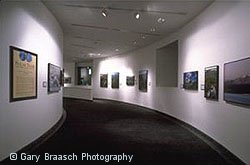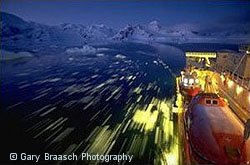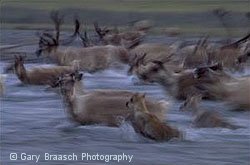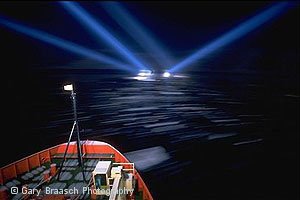Polar Thaw
“Climate Change in Our World” an exhibit of large-scale color photographs from the book “Earth Under Fire” opens at the American Association for the Advancement of Science Hq Atrium, Washington DC, November 10, 2009.
Companion exhibit for kids, parents and school groups, “How We Know About Our Changing Climate” will highlight how scientists learn about climate change and include kids taking action, in the films “Young Voices on Climate Change.”
“Climate Change in Our World” an exhibit of color photographs ranging to 5 feet high from the book Earth Under Fire: How Global Warming is Changing the World premiers at AAAS Hq Atrium, November 10 through mid-March 2010. The images are by environmental photojournalist Gary Braasch, winner of the Ansel Adams Award, who has been documenting climate change and its solutions for a decade.
“How We Know About Our Changing Climate: Learning and Taking Action on Climate Change” is an educational exhibit and video installation which accompanies the show. Images from the book How We Know What We Know About Our Changing Climate: Scientists and Kids Explore Global Warming and the films “Young Voices on Climate Change” will teach and inspire school groups and families. The two combined exhibits and the films will travel to other museums after February 2010.
The time preceding the Copenhagen international climate negotiations will be an extraordinary moment of preparation, education and news focus, and the planned exhibit will be an important element in that. The exhibit will be visually arresting with five foot high prints, and with detailed captions carrying a forthright statement that the atmosphere is warming rapidly and hundreds of scientifically-documented effects can be seen around the planet. It also will illustrate the steps we must take to limit the warming and effects, which are creating a new world of technology, urban life, energy, labor and transportation.
Since the publication of Earth Under Fire in 2007, the images selected for the proposed exhibit have consistently been among the most shocking, riveting and illuminating to thousands of readers and viewers of presentations. The book, published by University of California Press, was issued in an up-to-date revision this spring.
Images in the companion teaching exhibit are from the children’s book How We Know What We Know About Our Changing Climate: Scientists and Kids Explore Global Warming by Lynne Cherry and Gary Braasch (Dawn Publication 2008). The book is the most honored young-reader science book of the past year, with 15 major awards including Middle Grades Science Book of the Year by the AAAS and top awards from the Burroughs Foundation, National Science Teachers Assn. and others. It shows how scientists are observing nature and discovering the changes and correlations of global warming, and how kids can learn about scientific observations and take action about climate change
The exhibits are organized by Gary Braasch, author of Earth Under Fire and creator of the World View of Global Warming project.; in collaboration with Lynne Cherry, co-author with Braasch on the children’s book and producer of “Young Voices” films. Shirley Koller, art consultant for AAAS is the curator.
Polar Thaw Climate Exhibit

"Polar Thaw" a 30-print exhibit of photographs
from locations of Arctic and Antarctic climate warming, opened spring
2000 at the American Association for the Advancement of Science, Washington
DC. It has also been exhibited at the Science Museum of Minnesota, and
is at the Field Museum of Natural History in Chicago during fall 2003
This exhibit, with detailed, informative captions, is
available for display in museums, science centers, public libraries, and
other funded venues. Visit http://www.nrdc.org/globalwarming/polar/polarinx.asp.

National Science Foundation icebreaker Nathaniel B. Palmer
cruises at dusk in the Antarctic Peninsula, on a study of disintegrating
ice shelves. Print from "Polar Thaw" exhibit (see
below).

Caribou of the Porcupine Herd in the U.S. Arctic National Wildlife Refuge,
Alaska, during their annual migration. This herd and other large mammals
are threatened by changes to arctic ecosystems due to the warmest temperatures
in at least 400 years. Print from "Polar Thaw" exhibit.
POLAR THAW: Global Warming in the Arctic and Antarctic
- An exhibit on early yet powerful effects of climate change in the
polar regions.
- Thirty large color prints, mounted, captioned, and ready to hang.
- For science museums, technology centers, and other public venues.
- Sponsored by Natural Resources Defense Council. http://www.nrdc.org/globalWarming/polar/polarinx.asp
- First shown at American Association for the Advancement of Science Gallery, Washington D.C., spring 2000.
For details on how to lease this exhibit, see below and contact Gary Braasch, requestinformation@worldviewofglobalwarming.org
Background to the exhibit and the facts of climate change at the poles.
The last years of the 20th Century were the warmest years
of the past thousand, and the first years of the 21st continue a long-term
trend toward a much warmer climate. Scientists report that since the mid
1970s, the average global surface temperature has increased at a rate
of more than .2° C per decade.
The IPCC international science study of climate change
predicts readings will be 2-6° C higher by 2100 if emissions of heat
trapping industrial gases are not reduced. By comparison, the world has
warmed by 5 - 9° C since the depths of the last ice age, about 18,000
years ago. The same climate models predictive of temperature rise also
show the atmosphere heating faster at the poles than other places on the
planet.

The polar regions have been terra incognita for
scientists and the holy grail for explorers since the 16th century. Although
the days of Hudson, Cook, Shackleton, Amudsen, Byrd, Nansen and Peary
are gone, the quest for knowledge in these forbidding climes has not ended.
New mysteries such as climate changes have drawn scientists to the high
latitudes.
COPYRIGHT NOTICE:
Photography and text Copyright © 2005 - 2017 (and before) Gary Braasch All rights reserved. Use of photographs in any manner without permission is prohibited by US copyright law. Photography is available for license to publications and other uses. Please contact requestinformation@worldviewofglobalwarming.org. View more of Gary Braasch's photography here.


